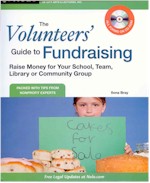 |
|
|
| ||||||
|
|
This page is the original source of this review, though you may also find it on Amazon or other sites. | ||
| Book Reviews Home | Free Audio Books | |
 |
The Volunteer's Guide To FundraisingRaise money for your school, team, library, or community group Price: $18.47 Availability: Usually ships within 24 hours |
| Review of
The Volunteer's Guide To Fundraising, by Ilona Bray, JD (Softcover, 2011) (You can print this review in landscape mode, if you want a hardcopy) Reviewer: Mark Lamendola, author of over 6,000 articles. Well done! I've served on several non-profit boards over the years, and definitely see the need for a book on this topic. I'm pleased with the approach this book takes to addressing the topic of how volunteers can make the best use of their limited resources (including their time) to raise funds for their organization. Some of the things that organizations do to raise funds border on loony. And many others are a complete waste of time, while some cost more than they raise. People do these things because someone has an idea and just won't let it go. Personal power, rather than reasoned analysis, carries the day. And often it carries the funds away. With this book, a board can limit the conversation to the techniques that actually work. There are about nine of these. The methodical and organized approach makes this book easy to implement. It also allows the book to be a reference in the fundraising process. So after you understand and apply Chapters 1, 2, 3, and 7 (the foundation information, with 7 applying only if you're holding fundraising events), you can pick the appropriate chapter among the remaining ones and use it as your guide. That is, the first 3 chapters apply to all fundraising efforts. Get things sorted out per those chapters, then you are ready to actually implement a fundraising method of your choice.
The writing was unusually clear and error-free, which is a plus. Many books today show scant regard for grammar or composition, so it's nice to see something written correctly. The copy-editing was obviously thorough, too. Being a nitpicker, I appreciate that effort. I know it's not easy. The author used a conversational style, making this book easy to read. Another reason that style works is each chapter is apparently the contribution of a subject matter expert. Each begins with a "Meet your advisor" blurb along with photo. This book consists of 13 chapters spanning 375 pages, a thoughtful introduction, an appendix, and an index. It also comes with a CD that contains a 38-page bonus chapter on applying for grants, plus 19 template documents that work in standard office applications (e.g., MS-Word). Those 19 documents include letters, worksheets, receipts, and application forms. As mentioned, the 13 chapters include three foundational chapters that apply to all fundraising activities:
Plus Chapter 7, if you are doing a fundraising event. The remaining nine chapters address specific fundraising methods:
If you're on the board of a non-profit (registered or not, incorporated or not), you need a copy of this book. If you're thinking about serving on a board, pick up a copy of Roberts Rules of Order (so you understand parliamentary procedure, which is critical to having orderly, productive meetings) and read this book so you can come on board with something great to offer--how to juice up the organization's revenue without burning people out. | |
About these reviewsYou may be wondering why the reviews here are any different from the hundreds of "reviews" posted online. Notice the quotation marks? I've been reviewing books for sites like Amazon for many years now, and it dismays me that Amazon found it necessary to post a minimum word count for reviews. It further dismays me that it's only 20 words. If that's all you have to say about a book, why bother? And why waste everyone else's time with such drivel? As a reader of such reviews, I feel like I am being told that I do not matter. The flippancy of people who write these terse "reviews" is insulting to the authors also, I would suspect. This sound bite blathering taking the place of any actual communication is increasingly a problem in our mindless, blog-posting Webosphere. Sadly, Google rewards such pointlessness as "content" so we just get more if this inanity. My reviews, contrary to current (non) standards, actually tell you about the book. I always got an "A" on a book review I did as a kid (that's how I remember it anyhow, and it's my story so I'm sticking to it). A book review contains certain elements and has a logical structure. It informs the reader about the book. A book review may also tell the reader whether the reviewer liked it, but revealing a reviewer's personal taste is not necessary for an informative book review. About your reviewer
About reading styleNo, I do not "speed read" through these. That said, I do read at a fast rate. But, in contrast to speed reading, I read everything when I read a book for review. Speed reading is a specialized type of reading that requires skipping text as you go. Using this technique, I've been able to consistently "max out" a speed reading machine at 2080 words per minute with 80% comprehension. This method is great if you are out to show how fast you can read. But I didn't use it in graduate school and I don't use it now. I think it takes the joy out of reading, and that pleasure is a big part of why I read. |
| |||||